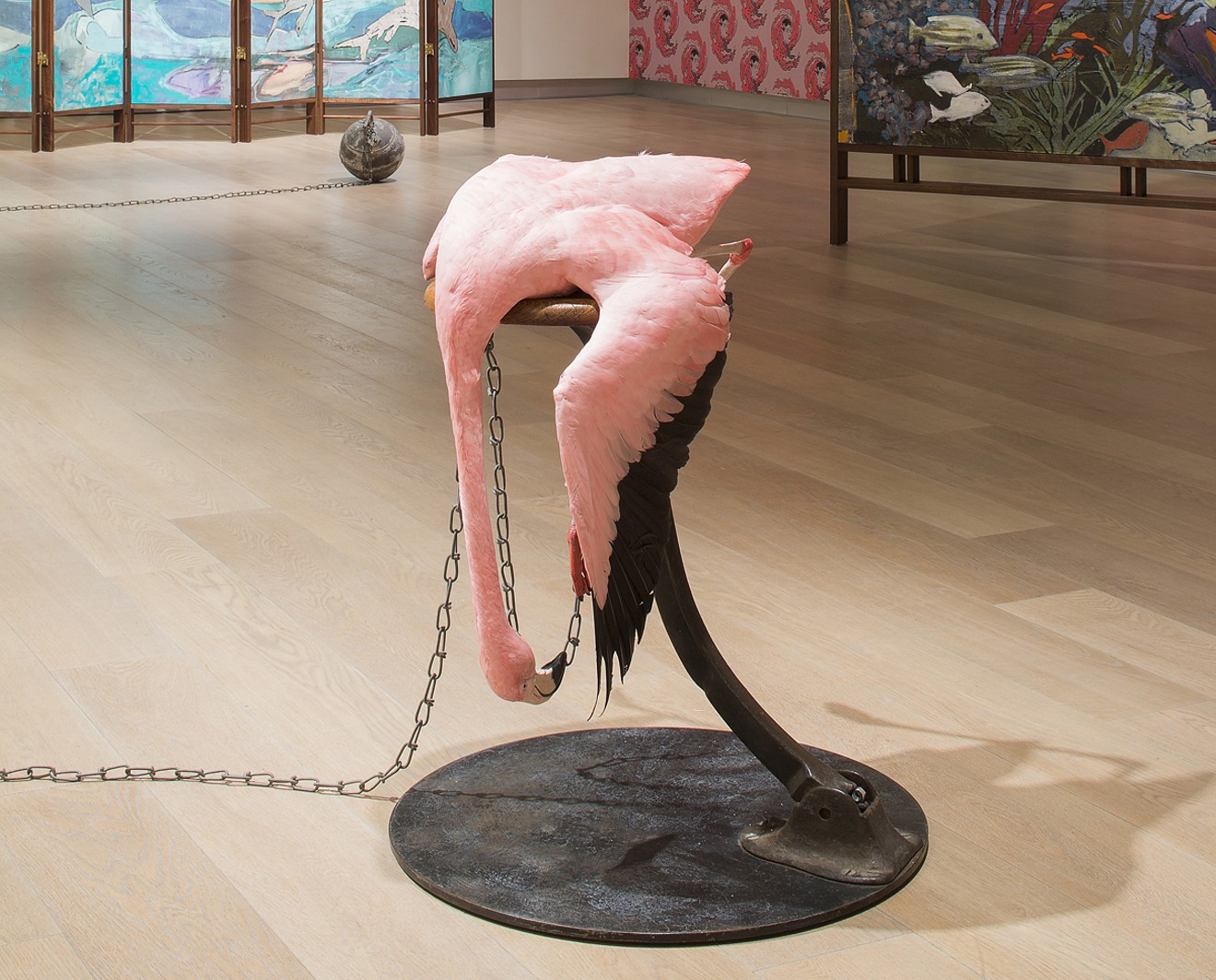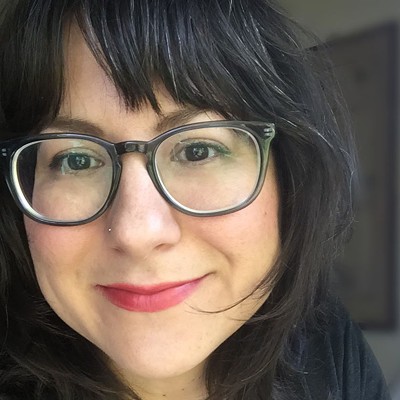Young men's heads bobbing in an ocean heavy with secrets painted on a folding screen. A flock of spoonbills flying by Stiltsville on a triptych. A sculpture of a dead flamingo, doubled over like a macabre midcentury modern table, chained to a metal ball. This is Hernan Bas' "Florida Living."
The exhibit, on display at the Savannah College of Art and Design Museum, shows a range of works created by the Miami-raised Bas. He is a talented visual storyteller whose work often feels more like timeless page-turners than paintings. It's not exactly light reading, not the "gay Hardy Boys" description that has stuck with the artist's creations from the early days. It's more like Bas is illustrating Oscar Wilde, one of his influences, with an eye on mid-20th-century design and Victorian oddities.
Based in both Miami and Detroit, the New World alum got his start working at the Rubell Family Collection and showing early on at the Moore Space in the Design District and at the 2004 Whitney Biennial in New York. He is represented by Lehmann Maupin Gallery in New York. His work is housed in the collections of many major U.S. art museums, from MOMA in Manhattan to MOCA LA. This year alone, he'll have exhibitions on three continents. New Times spoke with the artist about his younger years in Miami, his inspirations for "Florida Living," and his upcoming talk at ICA Speaks, where he will take a deeper look at the term once applied to homosexuals: "fruit."
"Just think Vizcaya, but slightly more gay."
tweet this
New Times: What was the cultural setting like when you were growing up in Miami? Before attending high school at New World School of the Arts, how much exposure did you have to the arts?
Hernan Bas: I can't recall being exposed to a cultural scene before maybe my junior year at New World, which would have been early '95. Like most of the people I know who grew up in Miami around the same time as me, it wasn't so much the city as it was television in general that gave me any idea of the world outside of here. Watching the music videos for Aha's "Take on Me" and Madonna's "Like a Virgin" solidified me wanting to be an artist. In that sense, I could have been anywhere and wanted to paint or make "art." Sorry, South Florida!
When you were younger, did you feel that starting your career in a city not known for its intellectualism or fine arts would hinder you as an artist, or did you feel like you had an opportunity to stand out here?
I never thought about those things, to be quite frank. I didn't exactly stumble into an art career, but there was never a situation where I ever felt hindered, at least when it came to being creative. Money, as with any young artist, was another story. I was making stuff on the assumption that hopefully someone would see it, and I never envisioned making a living at it. I've gotten a lot done in over 15 years at this. I work a lot, and I don't ever like to say I've been lucky, because to me, luck doesn't equate to eight or ten hours every day in your studio for years on end. If I've managed to stand out here, I consider a good deal of that is because of that work ethic.
You have a show up at SCAD Museum of Art, "Florida Living." There are a lot of flamingos in there, spoonbills, a lot of wildlife. Why did you focus on animals and nature in these paintings and sculptures? Why did you make the decision to include sculptures in this show?
The group of work currently on view at SCAD was originally developed to be shown on the other side of the world, quite a distance from Florida. The "exotic" (to be kind) nature of our dear state was something I've toyed with to some extent in the past but have been a bit shy about. When the work ended up just a few miles from the state line, I had to adjust to the reality that this stuff, literally, is pretty freaking close to home.
I don't like autobiographical references when it comes to my own work; I like to keep things vague enough to let the viewer write the story and not jam my own down their throats... As for the look of the works, one of my main interests was the tradition of decorative arts in the early 1900s in America: folding screens, wallpapers, etc. It's way too boring to elaborate on — just think Vizcaya, but slightly more gay.
Regardless, I've always had an affinity for flamingos; it's my weak spot from growing up here. I won't ramble too much here, but if you look at the sculptures at SCAD, the flamingos are tethered in a ball-and-chain manner and have seemingly died in the gallery from neglect. Take what you wish from that. There's a backstory, but save it for the art catalogs.
When did you decide to leave Miami, and why did you choose Detroit? What is life like for you up there on Service Street?
One of the reasons I began to spend time away from Miami was that people knew what street I worked on! So, just so you know, I'm not on Service Street anymore. I am actually in Miami more than Detroit and have been for a long time. People love the Detroit story, and I really like it there. I still maintain a great studio space there. But there are a good deal of artists working there who deserve attention and the "story" more than someone like me, who is weary of the editorial and enjoys the benefit of being left alone to work when I am there. Detroit is not "the new Berlin." It is Detroit, and I don't want to elaborate on the point because I'm from Miami. I'm still, after maybe nine years, a visitor there, and I respect that.
Is there anything you wish you were doing but aren't? Anything other than art-making? What are you working on next?
I want to see pink dolphins on the Amazon River. That said, I like painting every day, and my new studio has cable TV to listen to when I work, so I am pretty close to A-OK. As for what's next, this year I'll be showing at Galerie Peter Kilchmann, Zurich, in June; PKM gallery, in Seoul, in October; and Victoria Miro Gallery in London, also in October. All new paintings, building off of and inspired by my time at a residency program I was lucky to take part in last fall at Jesus College, Cambridge University, UK.
Finally, what are you going to speak about at ICA?
It's been a good long time since I've given a talk in Miami! I will be focusing on the last five or so years of paintings, discussing themes that range in topic from the mystery lights of Marfa, Texas, to a group of 36 "unknown poets," the not-so-subtle use of the term "fruits," and a fascination with '80s Memphis Group design group aesthetics. If that doesn't inspire you, come out just to ask the question I've been pondering for a while: "What makes this shit gay when there's no sex in the painting?"
Institute of Contemporary Art's ICA Speaks, With Hernan Bas
7 p.m. Thursday, May 11, at Miami Design District Palm Court, 140 NE 39th St., Miami; 305-901-5272; icamiami.org. Admission is free with RSVP via icamiami.org/rsvp-ica-speaks-hernan-bas.












